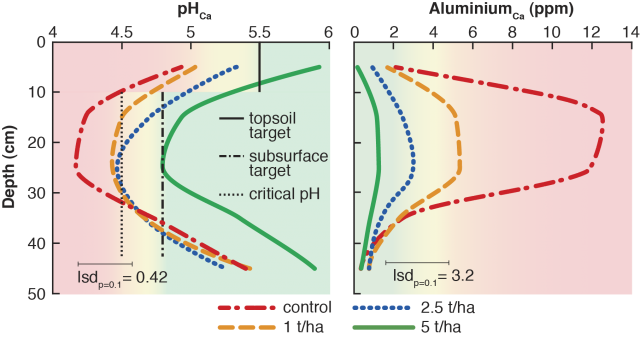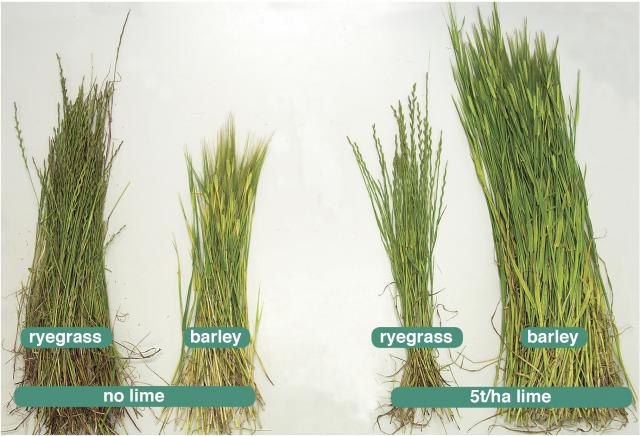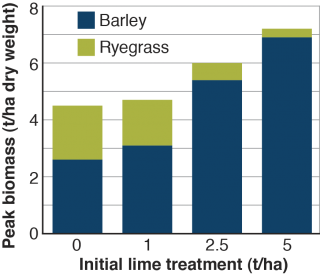David and Alex Leake, Kellerberrin: long-term benefits of liming
Property information
Average annual rainfall: 310mm
Enterprise mix: cereal-lupin rotation, usually 2-3 years wheat
Predominant soil types: tenasol (yellow sandy earth)
Background
David and Alex Leake established a trial in 1991 to investigate the benefits of liming sand plain soils. Following the Kellerberrin Demonstration Group field walk in 2008, the Department of Primary Industries and Regional Development and Precision SoilTech became involved as part of the Wheatbelt Natural Resource Management soil acidity project with funding from Caring for our Country.
Trial treatments and management
In 1991, limesand (with neutralising value 90%) was surface-applied to plots (15m x 100m) at 1, 2.5 and 5t/ha and replicated three times with an unlimed plot in each replicate as a control. The trial area was subject to the same management regime as the rest of the paddock.
In 2001, 1t/ha of limesand was surface-applied to all plots as part of whole-paddock liming. For ease of identification, the treatments are referred to by the initial lime application rates.
Soil pH and aluminium
The starting pHCa of the trial area, based on soil test results taken around the same time, was 4.8 in the surface and 4.5 in the 10-20cm layer. The soil pH deeper in the soil profile was not measured at the time but is assumed to have been around 5, which is typical for the soil type and cropping history.
In 2009, on the 2.5, 1 and 0t/ha plots, where insufficient lime had been applied, the soil pH profiles were increasingly acidic and aluminium levels increasingly toxic (Figure 1). To recover these soil pH profiles to meet DPIRD targets an estimated 7-10t/ha would be required and may take 10-20 years.

On the 5t/ha plot, where sufficient lime had been applied (6t/ha in total), the soil pH profile met the DPIRD recommended values 18 years after the initial application. At these levels, aluminium in the subsurface is nontoxic to root growth (Figure 2).
Similar results most likely would have been achieved by applying the 6t/ha of lime in two applications of 3t/h over the first 10 years. An additional 2t/ha of lime over the next 10 years will probably maintain the soil profile at the department's targets.
Wheat and barley grain yields
The 5t/ha limed plots yielded 0.58t/ha more wheat than the unlimed plots in 2008 and 0.55t/ha more in 2012 (Table 1). At wheat prices of $300/t this represented $174 and $165 extra per hectare respectively.
In 2009 the 5t/ha limed plots yielded 1.52t/ha more barley than the unlimed plots, representing $225 extra per hectare at barley prices of $174/tonne (t).
Managing soil pH in this trial returned $560 additional income per hectare over the three crops measured alone.
| Lime (t/ha) | 2008 wheat | 2008 wheat | 2009 barley | 2009 barley | 2012 wheat | 2012 wheat |
|---|---|---|---|---|---|---|
| N/A | t/ha | % of max | t/ha | % of max | t/ha | % of max |
| 0 | 2.92 | 83 | 0.7 | 32 | 1.64 | 75 |
| 1 | 3.30 | 94 | 1.10 | 50 | 1.74 | 80 |
| 2.5 | 3.20 | 91 | 1.76 | 82 | 1.79 | 82 |
| 5 | 3.50 | 100 | 2.22 | 100 | 2.19 | 100 |
Barley and weed biomass
Barley grain yield increases were not completely explained by the soil pH and aluminium profiles. There was a strong interaction between lime treatments and weed burden with the reduced weed burden on the 5t/ha plots contributing to the increased grain yield.
Limed plots produced 60% more barley biomass than unlimed plots and, in addition, unlimed plots contained proportionally more ryegrass than plots limed at 5t/ha 18 years ago (Figures 2 and 3). Increased crop competitiveness and potentially better herbicide efficiency on soils with good pH combine to fight weeds and reduce the weed seed bank over time.

Conclusions
Six tonnes per hectare (5t/ha initially, plus 1t/ha after nine years) of surface-applied lime was sufficient to recover topsoil pH and maintain it at or above pHCa 5.5 at 18 years after the initial application. This enabled the subsurface soil to be maintained at or above pHCa 4.8 to a depth of 50cm thus preventing aluminium toxicity.
Increased lime use has many benefits to the farming system in addition to increasing yields. Removing acidity as a constraint increased grain yield and crop competitiveness, reduced the weed burden and decreased the risk of soil erosion by increasing biomass cover.
David Leake believes that without liming his profitability and long term future would be in question. Having seen the benefits of liming, David is committed to an ongoing liming program involving the reliming of paddocks every 3-10 years depending on the amount of acidification. He sees a good return on investment by maximising the value of his other fertiliser and chemical inputs and by the improvement in yield continuing 15-20 years after liming.

